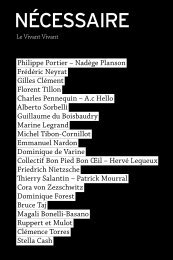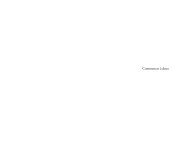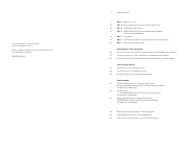dossier de presse - R-Diffusion
dossier de presse - R-Diffusion
dossier de presse - R-Diffusion
You also want an ePaper? Increase the reach of your titles
YUMPU automatically turns print PDFs into web optimized ePapers that Google loves.
Moreover, as for literary activity, there is<br />
no willingness to fit the art of building<br />
within a broa<strong>de</strong>r cultural dimension.<br />
Certainly, there had been the ephemeral<br />
occurrence of L’œuvre artistique organised<br />
by Gustave Serrurier-Bovy. A kind<br />
of Liège-based take on the Libre Esthétique<br />
circle in Brussels, the group which<br />
brought together architects, painters, musicians<br />
and patrons had presented a salon<br />
in 1895 focusing on the main figures of<br />
architecture and applied arts from the late<br />
19 th century. Yet, the movement did not<br />
survive this one-off initiative and was not<br />
able to sustain an opening on mo<strong>de</strong>rn architecture.<br />
In the inter-war period in Liège,<br />
few architects dare upset the provincial<br />
tepidity anymore. And those who do<br />
remain very cautious by publishing a few<br />
mo<strong>de</strong>rately challenging articles in specialised<br />
magazines. This is why the launch of<br />
L’Equerre in 1928 can be consi<strong>de</strong>red both<br />
an exceptional and courageous initiative.<br />
In<strong>de</strong>ed, there may be room for it but the<br />
context in which a new discourse is expected<br />
to <strong>de</strong>velop is not welcoming.<br />
II.<br />
I'm a Mo<strong>de</strong>rnist, so I<br />
subscribe to L'Equerre<br />
The programme<br />
Paul Jaspar, Projet <strong>de</strong> monument commémoratif à Liège, 1921. Extrait <strong>de</strong> L’Émulation, Bruxelles, 1921.<br />
/<br />
Paul Jaspar, Memorial Project in Liège, 1921. Taken from L’Émulation, Brussels, 1921.<br />
“[…] isn’t contemporary construction<br />
based on error? I mean, error in the broad<br />
sense?... Once built, mo<strong>de</strong>rn <strong>de</strong>sign begins<br />
to die and it dies quickly : maintenance<br />
is impossible, for there is no possibility<br />
of repair. The proof is in the refuse piling<br />
up around our homes, and their accumulation<br />
speaks volume!... bits of concrete,<br />
Eternit or enamelled waste, even small<br />
objects: chrome armchairs, tin cans, and<br />
so on... and so forth, all irreparable and in<strong>de</strong>structible<br />
when out of use [6] .” In the late<br />
1930s, in the twilight of his life, he is still<br />
claiming his incomprehension of the mo<strong>de</strong>rnist<br />
movement: “We, the el<strong>de</strong>rs, blame<br />
the young generation for abandoning the<br />
pursuit of beauty. What is beauty? Is it<br />
simplicity alone, nihilism? Alas, we fear<br />
these only show helplessness [7] !”<br />
Created in Liège at the end of 1928,<br />
L’Equerre is a latecomer in the selection<br />
of avant-gar<strong>de</strong> publications. Among “the<br />
great Mo<strong>de</strong>rnist magazines, which have<br />
already annihilated the army of retrogra<strong>de</strong>s<br />
and antique <strong>de</strong>alers [8] ,” L’Equerre finds<br />
its main source of inspiration in 7 Arts of<br />
which it seems to be the prolongation. Actually,<br />
the Liège-based magazine borrows<br />
its name from the publishing co-operative<br />
that Pierre and Victor Bourgeois had<br />
foun<strong>de</strong>d in or<strong>de</strong>r to <strong>de</strong>velop their writing<br />
activity. Like its pre<strong>de</strong>cessor, it is waging<br />
a fight, a war even, against the “old world”.<br />
Both publications have much in common,<br />
in their architectural beliefs and<br />
the way they express these. Even though<br />
the founding act is not encapsulated in a<br />
manifesto, the intentions of L’Equerre are<br />
regularly reiterated and in line with the<br />
[6] JASPAR, Paul, “À propos d’architecture régionale”<br />
in Bâtir, No. 9, Brussels, 15 August 1933, p. 321.<br />
[7] JASPAR, Paul, L’architecte liégeois Paul<br />
Jaspar. Un siècle d’architecture en Belgique,<br />
unpublished autobiography, p. 107<br />
[8] “Troisième année” in L’Equerre,<br />
No. 1, October 1930, p. 3.<br />
38




![Télécharger le pdf de présentation [pdf] - Théorie Design Graphique](https://img.yumpu.com/25633762/1/184x260/taclaccharger-le-pdf-de-pracsentation-pdf-thacorie-design-graphique.jpg?quality=85)



